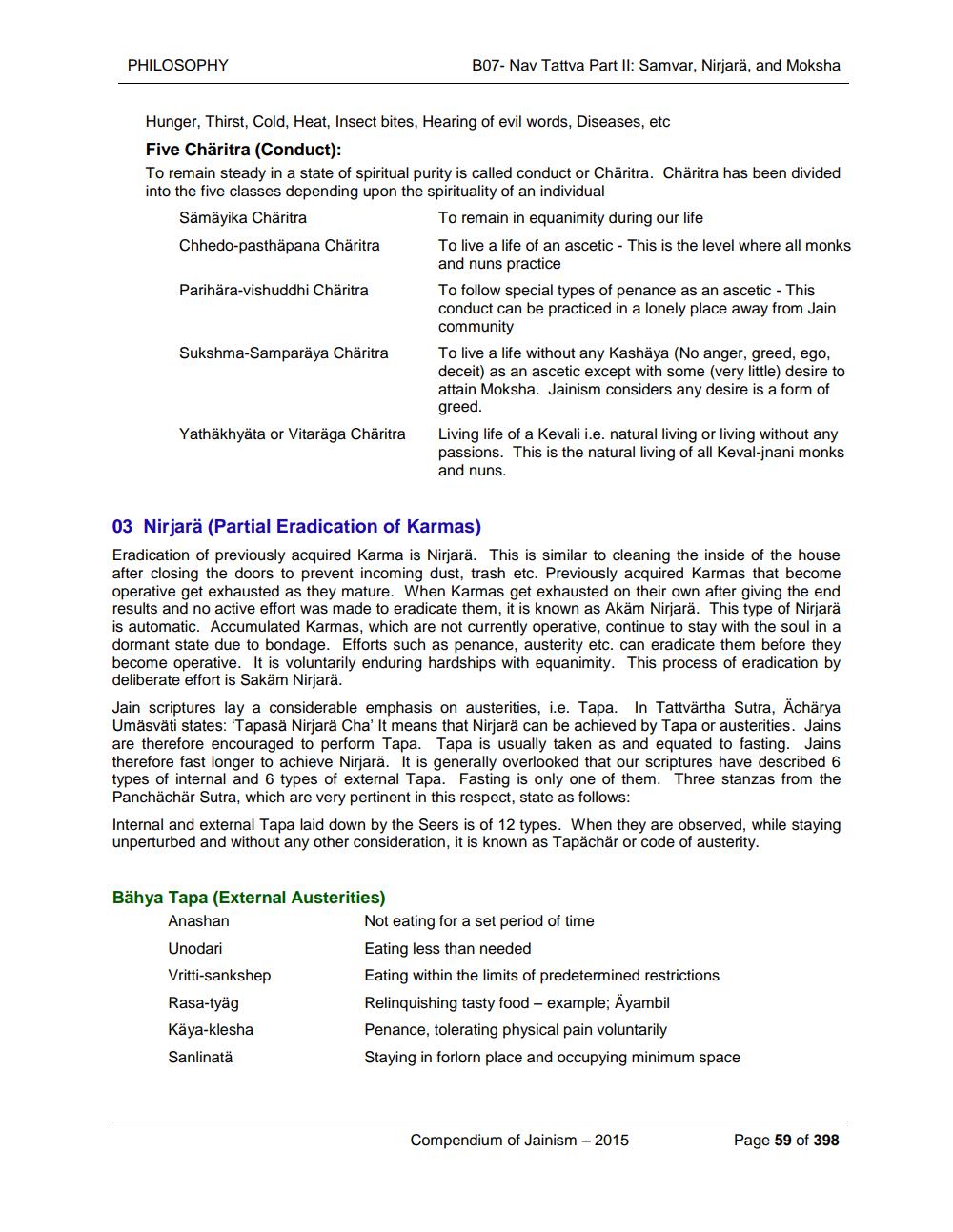________________
PHILOSOPHY
B07- Nav Tattva Part II: Samvar, Nirjarä, and Moksha
Hunger, Thirst, Cold, Heat, Insect bites, Hearing of evil words, Diseases, etc Five Charitra (Conduct): To remain steady in a state of spiritual purity is called conduct or Charitra. Charitra has been divided into the five classes depending upon the spirituality of an individual Sämäyika Charitra
To remain in equanimity during our life Chhedo-pasthäpana Charitra To live a life of an ascetic - This is the level where all monks
and nuns practice Parihära-vishuddhi Charitra
To follow special types of penance as an ascetic - This conduct can be practiced in a lonely place away from Jain
community Sukshma-Samparaya Charitra
To live a life without any Kashäya (No anger, greed, ego, deceit) as an ascetic except with some very little) desire to attain Moksha. Jainism considers any desire is a form of
greed. Yathäkhyäta or Vitaraga Charitra Living life of a Kevali i.e. natural living or living without any
passions. This is the natural living of all keval-jnani monks and nuns.
03 Nirjarä (Partial Eradication of Karmas) Eradication of previously acquired Karma is Nirjarä. This is similar to cleaning the inside of the house after closing the doors to prevent incoming dust, trash etc. Previously acquired Karmas that become operative get exhausted as they mature. When Karmas get exhausted on their own after giving the end results and no active effort was made to eradicate them, it is known as Akäm Nirjarä. This type of Nirjarä is automatic. Accumulated Karmas, which are not currently operative, continue to stay with the soul in a dormant state due to bondage. Efforts such as penance, austerity etc. can eradicate them before they become operative. It is voluntarily enduring hardships with equanimity. This process of eradication by deliberate effort is Sakäm Nirjarä. Jain scriptures lay a considerable emphasis on austerities, i.e. Tapa. In Tattvärtha Sutra, Acharya Umäsväti states: Tapasä Nirjarä Cha' It means that Nirjarä can be achieved by Tapa or austerities. Jains are therefore encouraged to perform Tapa. Tapa is usually taken as and equated to fasting. Jains therefore fast longer to achieve Nirjarä. It is generally overlooked that our scriptures have described 6 types of internal and 6 types of external Tapa. Fasting is only one of them. Three stanzas from the Panchächär Sutra, which are very pertinent in this respect, state as follows: Internal and external Tapa laid down by the Seers is of 12 types. When they are observed, while staying unperturbed and without any other consideration, it is known as Tapächär or code of austerity.
Bähya Tapa (External Austerities) Anashan
Not eating for a set period of time Unodari
Eating less than needed Vritti-sankshep
Eating within the limits of predetermined restrictions Rasa-tyag
Relinquishing tasty food - example; Äyambil Käya-klesha
Penance, tolerating physical pain voluntarily Sanlinata
Staying in forlorn place and occupying minimum space
Compendium of Jainism - 2015
Page 59 of 398




